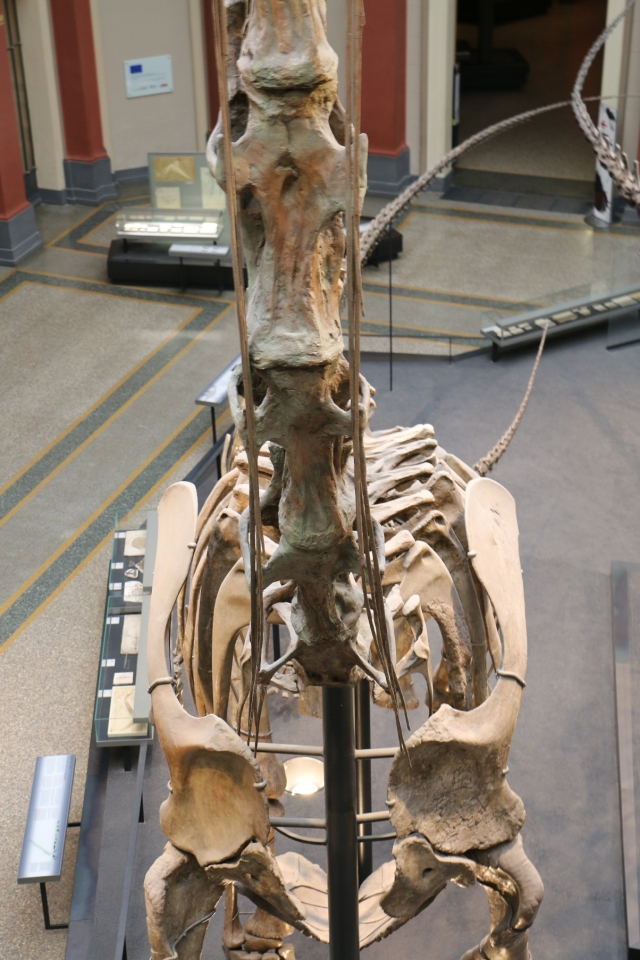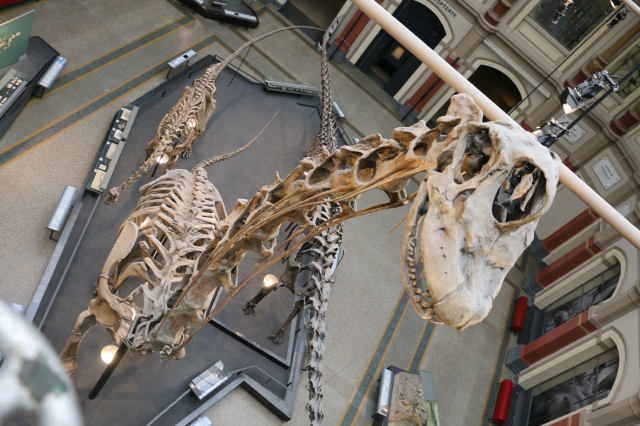TL; DR: loads cool pics of dinosaurs at end of post.
Recently, a colleague contacted me via email. He wanted to know if he could use the opportunity of his Berlin visit for SVP to climb up a ladder and have some fun with a tape measure and the limbs of Giraffatitan (ex Brachiosaurus). He was interested in the minimal shaft circumferences of humeri and femora, from which one can calculate a rough estimate of total body weight (see here). That’s been done for Giraffatitan, but apparently it all traces back to a personal communication from ages ago.
Well, access to the mounted skeleton is difficult under the best of circumstances. The platform the skeletons in the MfN’s Dinosaur Hall rest on is covered by a roughened surface that is rather delicate, so you can’t simply walk all over it. And walking in socks can be quite uncomfortable. And that is the least of your worries, if you want to access anything above elbow/knee level: Giraffatitan is rather tall, but placing ladders close to the skeleton is not that easy, given the touchy surface and the fact that there are railings and other skeletons and whatnot around it.
Additionally, the museum is open all week except Mondays, and we do not like having people climb all over the exhibits during visiting hours. Simply so that we do not give our museum visitors stupid ideas……. So you’re either limited to the early morning and late evening hours – if a curator is willing to come in really early or stay really late. Or you can show up on a Monday (obviously pre-announced) and have all day. Not just any Monday, though – occasionally, the museum is open to the public on Mondays, too. This was the case for the two weeks this fall due to school holidays.
Now add SVP to that (the annual meeting of the Society of Vertebrate Paleontology), with some 1300 crazy vertebrate palaeontologists descending on Berlin, and the corresponding demand to see the collections in the week before and after the meeting….. yes, there are quieter times to get into the Dinosaur Hall than those two weeks this fall. And the SVP meeting week’s Monday happened to be the first Monday after two weeks of the museum being open, which means that it was the Monday the cleaning crew really needed to get in there. Oh, and by sheer luck, it was the Monday on which an orchestra had the hall for a rehearsal for a concert later that week. It never rains, but it pours.
So, the Monday right before SVP was a total no-go. I couldn’t help my colleague either, even though quite obviously there is a bit more wiggling room for employees than for externals. But even if there had been a short time window for me to access the skeleton with a ladder, I was busy as hell with other stuff – SVP in Berlin meant colleagues coming over, and two came over early whom I really needed to sit down with and talk fossils. More about that later; it’s cool stuff we work on together.
However, when I mentioned the cleaning crew, I talked about the regular dusting and mopping. There’s more to keeping the Dinosaur Hall clean, including a yearly window cleaning. Yes, yearly is enough, because all the windows are indoors windows, in the walls between the Dinosaur Hall and neighbouring exhibition and collections rooms. But to access them one needs a lifting platform, a hydraulic hoist. And – guess what? – the annual window cleaning was up for the Monday after SVP. And the window cleaner is a really nice guy who doesn’t mind sacrificing part of his breaks in order to lift a crazy palaeontologist or two up into places they normally can’t get to.
So the next Monday, while I was horribly busy already managing (link to German news video) the Fraunhofer IDG automated 3D scanning test at the MfN, my colleague Matteo Belvedere and I used the lifting platform to get some measurements of the limb bones. And we used the opportunity to also take a lo of photos of the dinosaurs from viewpoints you usually can’t get to. Previously, I had used a ladder or took photos from 1st floor windows, but this was MUCH better 🙂
Two photos of me in action, both taken by Matteo Belvedere. Later, we switched roles with him up there and me on the ground, running off to run the CultLab3D thingy.
So, what about getting tight and cosy with Giraffatitan? Below you can see Matteo with the humerus, which was marked with tape in the three places we measured. While he was up there measuring I was standing ready to make notes. Note the scale bar we fixed to the vertical strut! Once I finish the photogrammetric models we can use this 1 m bar to scale them correctly.
Obviously, we now need to do some really hardcore science with that stuff, too – for now, I’ll just show you some of the pics we took.
A pterosaur’s view of Dicraeosaurus, slightly anterior. In this view it is really clear how 2D the sauropod is: it is high, it is long, but it isn’t wide!
A view from further away and to the left back. Note how the narrow silhouette get additional height from the tall neural spines.

And a look along the side of the back, showing off those spines to full effect. Giraffatitan‘s puny ones in back.
Riding Diplodocus this is the view you’d get at your 12. Note the used and unused rings for hanging the neck from the ceiling – obviously they are not supposed to take the full weight, but only part of it – and in the process dampen any oscillation of the neck in case it gets bumped.
A bit further back you can see the entire trunk and neck. As with Dicraeosaurus, this view highlights the extreme length versus a very reduced width. A legged snake? Not that far off.

Over to fat-bellied Giraffatitan! The wide transverse processes of the dorsals make this animal look like a snake on legs that just had a huge capybara for lunch. Or, rather, an entire elephant.

A closer view…..
and now for something completely different:
Tiny spiky Kentrosaurus! It is so small that a 4 m high ladder allows taking similar pictures. Thus, enough with ornithischians already, back to more chunky stuff:
Better! This view puts the nasty bird-hipper into the correct context with regards to dinosaur size! Yes, you can see that Tendaguru’s monster hedgehog – capable of 60 mph strikes with it’s 8x-basball-bat-weight tail tip – is not even half as long as the tail of Diplodocus. But then, isn’t it the tiny dogs that bite, making up their puny size with extra aggression? 😉
In fact, some sauropods did not have such huge, long tails! Check out the tail of Giraffatitan compared to Dicraeosaurus‘ and Diplodocus‘ tails and (part of Kentrosaurus) in this pic! It is still much longer than all of Kentrosaurus, but compared to the more regular, short-forelimbed and level-backed sauropods around it Giraffatitan has a short and slim tail.
Here, you can appreciate that it still is quite a significant tail. But compare the width of the tail to the width across the hips and across the middle of the trunk. Much slimmer tail than either Diplodocus or Dicraeosaurus. In fact, it looks almost mammalian, somewhat similar to a kangaroo or even less substantial.
To reiterate those points on narrowness of the trunk and ratio of tail to trunk width, here’s a view along the trunk and tail of Dicraeosaurus, taken from nearly directly above the neck base. See how the tail base is actually wider than the width across the tops of the ilia?
And more fat Giraffatitan rump. This view is really weird, but it does show up three things quite nicely: the wide back, the narrowness of the neck and the U-shape of the shoulder girdle.
Wwith the left forelimb in view you can’t see the back as well anymore, but the abrupt vertical front end is nicely on show. Compare to the horizontal orientation of a diplodocid – the long-armed, tilted-back sauropods are really weird!
A bit higher up we can get a total view. The perspective distortion makes the head look not ridiculously small as it really is, but it does highlight the stick-like neck.
OK, wrapping up with a portrait or two:
antero-lateral and very slightly ventral from the left and
lateral and very slightly ventral from the right. Say cheese!





















*sigh*
O once-in-a-lifetime opportunity. I am glad you were there to take it; but I can’t help being just a tiny bit jealous!
😀 I knew you’d feel this way. Poor Mike, so much in love with those beasts and relegated to ground level 😦
But maybe, if we time your next visit just right…….
Is the actual skull really mounted all the way up on the end of the neck? That seems rather inefficient, seeing as it means almost no one can ever study the original head of Giraffatitan without access to a hydraulic crane, and if anything were to ever happen to the connection between the head and the neck…no more Giraffatitan skull. Why don’t they put a cast on the skeleton and put the real skull closer to visitor level?
Nah, we’re not that stupid, are we? Luckily, it is a 3D print, high enough resolution. There is a second one at the beast’s feet, and the original is safely tucked away in collections 🙂
What lens(es) did you use to get these shots?
Steve, not sure – my colleagues EOS 70D with a Canon lens at 18 mm. Probably the kit one.
Thanks Heinrich, I assumed it was a wide lens from the distorted perspective on some shots.
But they offer a view that is hard to replicate.
yeah, no way one can use a normal lens for this! Matteo also has a zoom that goes down to 12, but luckily we didn’t need to employ that.
Fantastic! Thanks for posting these!